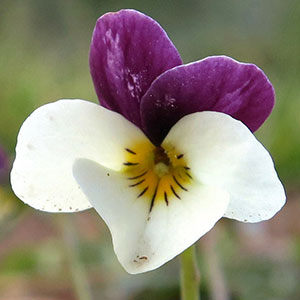Viola hallii
Viola frank-smithii
Hall's violet, Oregon violet, wild pansy
Frank Smith violet, Frank-Smith's violet
1–3, decumbent or ascending to erect, ca. 1/2 subterranean, glabrous, clustered on single, short, vertical, deep-seated caudex.
1–4, decumbent or ascending to erect, glabrous, on caudex from fleshy rhizome.
basal and cauline;
basal: 1–4, palmately compound, ± 2-ternate or 3-ternate, leaflets 3;
stipules adnate to petiole, forming 2 linear-lanceolate wings, unlobed, margins entire, apex of each wing free, acute;
petiole 5–8 cm, glabrous;
blade ovate to deltate, 2.8–6 × 2.6–6.5 cm, ± coriaceous, base tapered, ultimate lobes narrowly elliptic, lanceolate, or oblanceolate, 1–7 mm wide, margins entire, ciliate or eciliate, apex acute, mucronulate, surfaces glabrous;
cauline similar to basal except: stipules usually lanceolate, sometimes broadly ovate, ± leaflike, margins toothed;
petiole 1.3–6 cm;
blade 2–4.8 × 1.2–5.5 cm.
basal and cauline;
basal: 2–3;
stipules lanceolate, margins fimbriate, apex acute;
petiole 1.5–6(–14) cm, glabrous;
blade broadly ovate to deltate, 1.3–2.9(–4.1) × 1.3–2.9 cm, base cordate to truncate, margins crenate, eciliate, apex obtuse to rounded, surfaces glabrous;
cauline similar to basal except: petiole 1.3–6.5 cm;
blade 1.1–2.2 × 0.7–1.6 cm.
2.5–11 cm, glabrous.
2.5–7(–11.2) cm, glabrous.
sepals lanceolate to ovate, margins ciliate, auricles 0.5–1 mm;
petals: upper 2 almost black abaxially, dark reddish violet adaxially, lower 3 pale yellow, cream, or ± white, lateral 2 bearded, with deep yellow to orange patch basally, dark reddish violet-veined, lowest with deep yellow to orange patch basally, dark reddish violet-veined, 5–18 mm, spur yellow, gibbous, 0.5–2 mm;
style head bearded; cleistogamous flowers absent.
sepals lanceolate to linear-lanceolate, margins eciliate, auricles 0.5–1.5 mm; all petals usually pale purple, sometimes almost white adaxially, lateral 2 and lowest purple-veined, lateral and upper 2 violet abaxially, white basally, lateral 2 bearded, lowest 10–16(–18) mm, spur greenish to pale lime green, gibbous, 1.6–3 mm;
style head bearded; cleistogamous flowers unknown.
ellipsoid, 4–12 mm, glabrous.
ovoid, 3–7 mm, glabrous.
light brown, shiny, 3.2–3.5 mm.
pale yellow, 2.4–2.8 mm.
= 60, 72.
Viola hallii
Viola frank-smithii
Viola hallii was discovered on the grounds of Willamette University in Salem, Oregon, by Elihu Hall, a professor at that institution (V. B. Baird 1942). Leaves of V. hallii are similar to V. beckwithii.
(Discussion copyrighted by Flora of North America; reprinted with permission.)
Of conservation concern.
Viola frank-smithii is endemic to Logan Canyon, Cache County, Utah. N. H. Holmgren (2005d) wrote that it likely has its ancestral ties with V. adunca.
(Discussion copyrighted by Flora of North America; reprinted with permission.)


